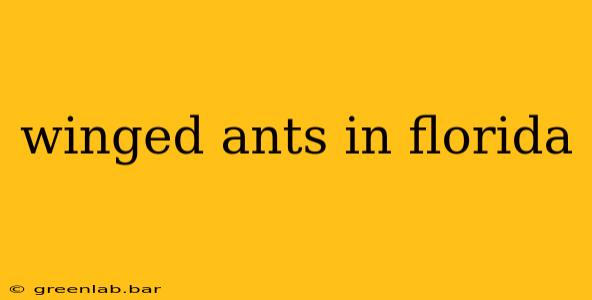Florida's warm, humid climate provides a perfect breeding ground for a variety of ant species, many of which develop winged reproductives, often mistaken for termites. Understanding the differences and effective control methods is crucial for homeowners and businesses alike. This guide delves into the common winged ant species found in Florida, their identification, and strategies for managing infestations.
Identifying Winged Ants in Florida: Beyond the Basics
While all winged ants share the characteristic wings, differentiating them from termites and even other ant species requires close observation. Here's a breakdown of key identification features:
Distinguishing Winged Ants from Termites:
The most common confusion arises between winged ants and termites, both of which are often found swarming. Here's how to tell them apart:
- Wings: Ants have two pairs of wings; the front pair is significantly larger than the hind pair. Termites have four wings of roughly equal size and length.
- Body: Ants have a distinctly segmented body with a narrow waist (petiole) between the thorax and abdomen. Termites have a broader waist and a more uniform body shape.
- Antennae: Ants possess bent or elbowed antennae. Termites have straight antennae.
Common Winged Ant Species in Florida:
Florida's diverse ant population includes several species that develop winged reproductives during swarming season. Some of the most common include:
-
Carpenter Ants ( Camponotus species): These large ants are often black or reddish-black. Their wings are dark, and they are known for nesting in wood, though they don't consume it like termites. Identifying carpenter ants requires careful examination of their size and body shape.
-
Sugar Ants ( Monomorium saccharini): These small, light brown ants are frequently found indoors, attracted to sweet substances. Their wings are proportionally smaller compared to their bodies.
-
Odorous House Ants ( Tapinoma sessile): These ants emit a characteristic rotten coconut odor when crushed. They are small and dark brown, with relatively small wings.
-
Argentine Ants ( Linepithema humile): These invasive ants are small and light brown to black. They are known for forming massive colonies and can be challenging to control.
Effective Strategies for Winged Ant Control in Florida:
Dealing with a winged ant infestation requires a multi-pronged approach focusing on both prevention and eradication.
Prevention:
- Eliminate food sources: Clean up spills, crumbs, and other food debris promptly. Store food in airtight containers.
- Control moisture: Ants are attracted to moisture. Repair leaks, address drainage issues, and ensure proper ventilation to reduce humidity levels.
- Seal entry points: Caulk cracks and crevices in walls, foundations, and windows to prevent ants from entering your home or building.
- Regular cleaning: Maintain a clean and clutter-free environment, both indoors and outdoors.
Eradication:
- Identify the nest: Locating the ant nest is crucial for effective control. Follow the trail of ants to find the source of the infestation.
- Professional pest control: For large or persistent infestations, contacting a qualified pest control professional is recommended. They possess the expertise and tools to effectively treat the problem.
- Targeted treatments: Various insecticides are available, but always follow the manufacturer's instructions carefully. Consider using bait stations for effective control.
Conclusion:
Dealing with winged ants in Florida requires careful observation and a proactive approach. By accurately identifying the species and employing appropriate prevention and control measures, you can effectively manage these common pests and protect your property. Remember, prevention is key, and early intervention can prevent a minor issue from becoming a major infestation. If unsure about identification or control methods, consult a local pest control professional for expert advice.

